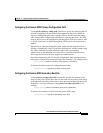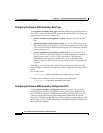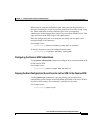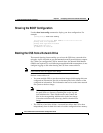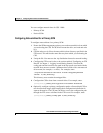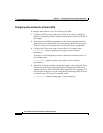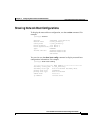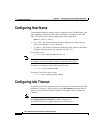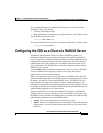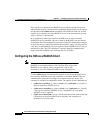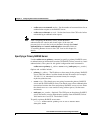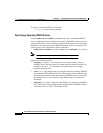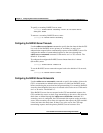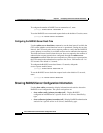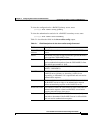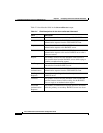
2-27
Cisco Content Services Switch Basic Configuration Guide
78-11424-03
Chapter 2 Configuring User Profiles and CSS Parameters
Configuring the CSS as a Client of a RADIUS Server
It is recommended that you configure the idle timeout to at least 30 minutes.
Setting this value to 30 minutes:
• Cleans up idle Telnet sessions
• Helps prevent busy conditions due to a high number of active Telnet sessions
To set an idle timeout value, enter:
(config)# idle timeout 15
To revert the terminal timeout value to its default of enabled for 5 minutes, enter:
(config)# no idle timeout
Configuring the CSS as a Client of a RADIUS Server
The Remote Authentication Dial-In User Server (RADIUS) protocol is a
distributed client/server protocol that protects networks against unauthorized
access. It uses the User Datagram Protocol (UDP) to exchange authentication and
configuration information between the CSS authentication client and the active
authentication server that contains all user authentication and network service
access information. The RADIUS host is normally a multiuser system running
RADIUS server software.
Use the radius-server command to configure the CSS as a client of a RADIUS
server for authentication requests by remote or local users who require
authorization to access network resources.
When a user remotely logs into a CSS operating as a RADIUS client, the CSS
sends an authentication request (including user name, encrypted password, client
IP address, and port ID) to the central RADIUS server. The RADIUS server is
responsible for receiving user connection requests, authenticating users, and
returning all configuration information necessary for the client to deliver services
to the users. Transactions between the RADIUS client and the RADIUS server are
authenticated through the use of a shared secret.
Once the RADIUS server receives the authentication request, it validates the
sending client and consults a database of users to match the login request. After
the RADIUS server performs userauthentication, it transmits one ofthe following
authentication responses back to the RADIUS client:
• Accept - The user is authenticated (all conditions are met).
• Reject - Theuser is not authenticatedand is prompted toreenter the username
and password, or access is denied (the username does not exist in the server’s
database).



